Related Research Articles

Nome is a city in the Nome Census Area in the Unorganized Borough of the US state of Alaska. The city is located on the southern Seward Peninsula coast on Norton Sound of the Bering Sea. It had a population of 3,699 recorded in the 2020 census, up from 3,598 in 2010. Nome was incorporated on April 9, 1901. It was once the most-populous city in Alaska. Nome lies within the region of the Bering Straits Native Corporation, which is headquartered in Nome.

James Wickersham was a district judge for Alaska, appointed by U.S. President William McKinley to the Third Judicial District in 1900. He resigned his post in 1908 and was subsequently elected as Alaska's delegate to Congress, serving until 1917 and then being re-elected in 1930. He was instrumental in the passage of the Organic Act of 1912, which granting Alaska territorial status. He also introduced the Alaska Railroad Bill, legislation to establish McKinley Park, and the first Alaska Statehood Bill in 1916. He was among those responsible for the creation of the Alaska Agricultural College and School of Mines, which later became the University of Alaska. A residence hall on the University of Alaska Fairbanks campus is named in his honor.
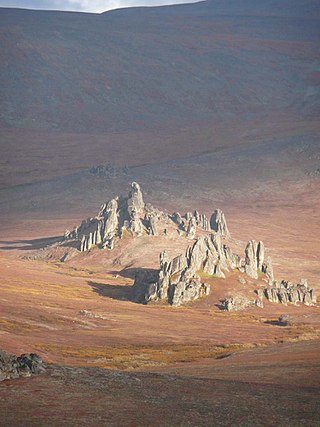
The Koyuk River is a river on the Seward Peninsula of western Alaska, in the United States. The river originates in the interior of the peninsula, at the Lost Jim Lava Flow of the Bering Land Bridge National Preserve, where it flows southeast towards the mouth of Norton Bay on Norton Sound. The native village of Koyuk is located at its mouth. The two major tributaries are the Peace and Salmon rivers; other tributaries include Dime and Sweepstakes.
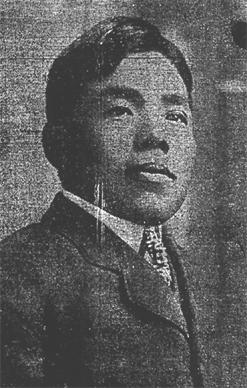
Jujiro Wada was a Japanese adventurer and entrepreneur who achieved fame for his exploits in turn-of-the-20th-century Alaska and Yukon Territory.
The Tubutulik River is a waterway in the U.S. state of Alaska. The 25-mile (40 km) long river is situated on the Seward Peninsula. It flows southeastwards to the Kwiniuk Inlet at the northwestern end of Norton Bay, 25 miles (40 km) southwest of Koyuk in the Bering Sea. Its Inuit name was reported as "Tubuktulik" in 1849 by Capt. Mikhail Dmitrievich Tebenkov of the Imperial Russian Navy. Exploration for placer gold occurred in the Council district area where the river valley is located, and in 1898, mining commenced. The production was substantial and ranked second only to that of Nome.

Cape Nome Mining District Discovery Sites is a National Historic Landmark located in Nome, Alaska. It was named a National Historic Landmark in 1978. It is significant for its role in the history of gold mining in Alaska, in particular the Nome Gold Rush that began in 1899.
Gold mining in Alaska, a state of the United States, has been a major industry and impetus for exploration and settlement since a few years after the United States acquired the territory in 1867 from the Russian Empire. Russian explorers discovered placer gold in the Kenai River in 1848, but no gold was produced. Gold mining started in 1870 from placers southeast of Juneau, Alaska.
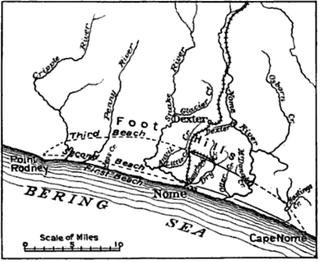
The Nome mining district, also known as the Cape Nome mining district, is a gold mining district in the U.S. state of Alaska. It was discovered in 1898 when Erik Lindblom, Jafet Lindeberg and John Brynteson, the "Three Lucky Swedes", found placer gold deposits on Anvil Creek and on the Snake River few miles from the future site of Nome. Word of the strike caused a major gold rush to Nome in the spring of 1899.
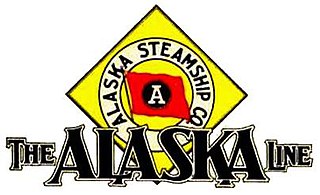
The Alaska Steamship Company was formed on August 3, 1894. While it originally set out to ship passengers and fishing products, the Alaska Steamship Company began shipping mining equipment, dog sleds, and cattle at the outbreak of the Klondike Gold Rush of 1897. The company was purchased by the Alaska Syndicate and merged with the Northwestern Steamship Company in 1909, but retained its name, and the fleet was expanded to 18 ships. During World War II, the government took over the company's ships. When the war ended, the company struggled to compete with the new Alaska Highway for passengers and freight. It discontinued passenger service altogether in 1954 and shut down operations in 1971.

Elbridge Truman Barnette was a Yukon riverboat captain, banker, and swindler, who founded the city of Fairbanks, Alaska, and later served as its first mayor.

Erik Lindblom (1857-1928) was a Swedish-American gold prospector. He was one of the "Three Lucky Swedes" who founded and developed the Nome mining district.

The Nome Gold Rush was a gold rush in Nome, Alaska, approximately 1899–1909. It is separated from other gold rushes by the ease with which gold could be obtained. Much of the gold was lying in the beach sand of the landing place and could be recovered without any need for a claim. Nome was a sea port without a harbor, and the biggest town in Alaska.
Candle Creek is a western tributary of the Kiwalik River, located on the Seward Peninsula of the U.S. state of Alaska. The unincorporated community of Candle is less than a mile away, while the village of Kiwalik is about 13 miles (21 km) away. The creek's name is attributed to the resemblance of the trees on the banks of the creek to candles when they are covered with snow. With the discovery of gold in 1901, Candle Creek's reputation as a top gold-yielding site was fixed.
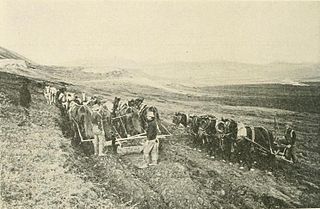
The Miocene Ditch is one of three historic ditches along the west side of the Nome River, on the Seward Peninsula, Alaska. It and the other two, the Seward and Pioneer ditches, were built to provide water to early placer mining operations near Nome. The Miocene is the oldest and longest of the three ditches, and the highest in elevation. From suitable places along the Nome-Taylor Road the ditches form distinct parallel lines crossing tundra promontories west of the river.

George Valdemar Borchsenius was an American attorney. He was the first clerk of the court of the Nome judicial division of Alaska.

The Wild Goose Railroad was created by the Wild Goose Mining Company in Alaska. Charles D. Lane acted as the President of the Wild Goose Mining company, until his death in 1911. The Wild Goose Railroad ran from Nome to Lane's Landing, named after Charles D. Lane, at the town of Shelton, in a straight line about 50 miles (80 km) north-northeast of Nome at the Kuzitrin River. In 1903, the Wild Goose Railroad was reorganized as the Nome Arctic Railway.
The Seward Peninsular Railroad (SPRR), often Seward Peninsula Railroad, is a former railway company in Alaska, United States. In 1900 Wild Goose Railroad was established, and on July 19, 1900 the first 6.5 km stretch of railway from Nome, Alaska to Discovery was laid. The track had a gauge of three feet (910 mm). The terminus at Anvil City was called Banner station. The trains ran only from spring to November, over the winter resting traffic.

Anvil Creek is a stream in Alaska. Part of it is in the Nome mining district near Nome, Alaska and became a center of gold rush attention after three Swedes found gold along it. The resulting influx of prospectors brought thousands of people to Nome in the spring of 1899.

Portus B. Weare was a wooden sternwheel steamship built in 1892 for service on the Yukon River. She played a notable role in the Klondike gold rush, being the second ship to bring news of the Klondike gold strike and an estimated $1 million in gold down the river in 1897. This set off the gold rush. The vessel carried freight and passengers up the Yukon to Dawson City and later Fairbanks. She was abandoned in 1926 or 1927, after the need for steamboat transport to the interior declined.
References
- ↑ McElwaine 1901, p. 243.
- ↑ Harrison, E. S. (1905). Nome and the Seward Peninsula: History, Description, Biographies and Stories. Souvenir Edition. Seattle: Metropolitan Press. p. 198.
- ↑ Brooks, Alfred H. (1908). Development of the Mining Industry. In The Gold Placers of Parts of Seward Peninsula, Alaska by A. J. Collier, F. L. Hess, P. S. Smith and A. H. Brooks, pp. 10-39. United States Geological Survey Bulletin 328. Washingtonm: U. S. Government Printing Office, Washington. p. 198.
- ↑ Trezona, C. E. (1900). Cape Nome and the Northern Placer Mines. Seattle: Denny-Coryell. pp. 7–8.
- ↑ Osborne, Alice (1972). "Rails Across the Tundra". The Alaska Journal. 2: 2–12.
- ↑ Leedy, John D. (1905). Nome's Advent as a Permanent Mining Field. Chapter VII in Seward's Land Of Gold, by L. H. French. New York: Montrose, Clarke & Emmons. pp. 50–51.
- ↑ "News from Council". The Nome Nugget. October 1, 1901.
- ↑ Wickersham, James (1938). Old Yukon: Tales-Trails-and Trials. St. Paul: West Publishing. p. 350.
- ↑ "C. D. Lane Sells Out". The Nome Nuggety. June 3, 1905.
- ↑ "Chas. D. Lane Passes Away". The Nome Nugget. May 27, 1911.
- ↑ Rickard 1909, p. 305.
- Bibliography
- Brooks, Alfred H. (1908). Development of the Mining Industry. In The Gold Placers of Parts of Seward Peninsula, Alaska by A. J. Collier, F. L. Hess, P. S. Smith and A. H. Brooks, pp. 10–39. United States Geological Survey Bulletin 328. U. S. Government Printing Office, Washington.
- Harrison, E. S. (1905). Nome and Seward Peninsula: History, Description, Biographies and Stories. Souvenir Edition. Metropolitan Press, Seattle.
- McElwaine, Eugene (1901). The truth about Alaska, the golden land of the midnight sun (Public domain ed.). The author.
- Rickard, Thomas Arthur (1909). Through the Yukon and Alaska (Public domain ed.). Mining and Scientific Press. p. 305.
- Smith, Howard L. (1997). Nome River Water Control Structures. BLM-Alaska Open File Repport 62. U. S. Department of the Interior, Bureau of Land Management, Alaska State Office, Anchorage.
- Wickersham, James. (1938).Old Yukon: Tales-Trails-and Trials. West Publishing, St. Paul.